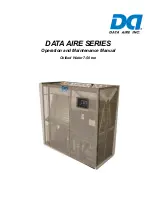
2
S
Minimum allowed glycol concentration: depending on the
minimum temperature of the ambient air expected at the
installation site (see Tab. a);
S
Maximum
difference of air side pressure (between the one
in the delivery duct and the one, possibly negative, in the
coil suction) equal to the max. one indicated in Tab. 9 next
to the max. signal = 10 V set on the microprocessor;
S
Maximum pressure of the hydraulic circuit: 5 bar;
S
Voltage range for the electric supply: 400 V
+
/
---
10%; max.
phase difference: 3%; tolerance on frequency: 1%.
Storage conditions: ---20
û
C
÷
45
û
C for all MATRIX R models.
2.2 --- Sound pressure levels
The Tab. 7 shows the noise data for the units in standard config-
uration (without pumps), operating continuously and measured
at 1 m from the coil side unit, with ducted air delivery and 50 Pa
of useful static pressure, in free field conditions.
The highest noise levels are detected for higher useful static
pressures of the air.
Note:
Avoid positioning in areas with possible reverberation of the
sound waves; acoustically insulate both the delivery and the in-
take ducts (if installed); failure to do this can adversely effect the
noise levels.
2.3 --- Transport
S
Handle the unit by lifting it with a crane from above;
S
The lifting holes are positioned in the frame’s base (when lift-
ing, use spreader bars to protect the sides, see Fig. 3, Fig. 4
and Fig. 5).
Note:
Place the lifting tubes in the holes in the base indicated by ”LIFT
HERE”. Lock the ends of the tubes with the locking pins and
splits pins as shown in Fig. 3 and Fig. 5. As an alternative (on
mod. 004---016 only), shackles/hooks (optional) fastened at the
base ends can be used as a lifting system: in this case the lifting
point must be on the vertical line passing through the machine’s
centre of gravity (as indicated in Fig. 4) to prevent any load im-
balance.
The capacity of the lifting gear must be adequate to lift the load
in question. Check the weight of the units, the capacity of the lift-
ing gear and ropes and the condition and suitability of the afore-
mentioned equipment.
2.4 --- Foundations
S
The unit must be placed on a level surface which will support
its weight.
S
If necessary, position the unit on suitable anti---vibration sup-
ports that can be supplied as an option (in rubber or spring---
type). Refer to the manual ”Installation of the spring anti---
vibration supports” for their correct positioning.
S
When positioned, level the unit.
Note:
For weight distribution see Fig. 6 and Fig. 7.
Note:
The weights and their distribution refer to standard units without
options; if the pump assembly, or other options are installed on
the machine, add the weights of the installed accessories to
those of the standard units (see Tab. 8).
2.5 --- Service area
S
In order to allow free air flow or to enable the ducting installa-
tion and maintenance of the unit, a minimum area must be
left free of obstructions around the unit (see Fig. 1 and
Fig. 2).
S
Avoid recirculation of hot air between the outlet and the out-
door intake of the air conveyed in the ducts, otherwise the
unit performance may be impaired or the standard oper-
ation can be interrupted.
3 --- Installation
3.1 --- Aeraulic connections
The Matrix R units are arranged with connection flanges for the
air intake and delivery ducts; if the units are ordered with metal
filters to protect the condensing coils, the connection flanges for
the intake side ducting are not supplied, as there is no duct to
enable the cleaning of such filter.
Connect the ducts fitting flexible joints to prevent transmitting
vibrations and to compensate thermal expansion. Check if the
holes on the walls --- where the intake and delivery ducts are
fitted --- are protected by suitable anti---rain grilles (equipped
with pre---filter like the intake ones) to avoid water or dust toenter
in the chiller.
All fans are adjusted at the same speed, so that it is not necess-
ary to install overpressure dampers next to each fan discharge.
The units are supplied with a setting in the microprocessor for
the max. fan speed of 50 Pa useful pressure; set the max. speed
according to the features required by the installation (see
Tab. 9).
The units are supplied with the condensation air discharge up-
wards; during the installation, it is possible to change the posi-
tion of the air discharge opening (with right or left horizontal
direction) by simply inverting the position of the drilled panel
with the closed one of the required side (see size drawings).
3.1.1 -- External air temperature probe installation
Install the external air temperature probe (shipped inside the
electric panel), at the end of the air intake duct.
The bulb must be positioned as much outside as possible but
must not be exposed to direct sunlight or weather agents such
as rain or snow. The unit operation could be jeopardized if these
precautions are not applied.
If the intake side duct is not present, fasten the probe in the room
so that it can correctly detect the external temperature of the coil
intake outer air withoutbeing influenced by other externalfactors
(sun rays, rain or snow, other heat or radiation sources, etc.).
3.2 --- Hydraulic connections
3.2.1 -- Hydraulic circuit construction (Fig. a)
The piping must be connected to the chiller. Construct a chilled
water circuit as described below, see Fig. a:
1) Place shut---off valves within the circuit to allow servicing;
2) Install a pump system suitable for the flow rate required at
a pressure head equal to the sum of all the pressure drops
(see project data).
Matrix R chillers can be equipped, upon request, with
pumps having performance as indicated in Tab. 8;
3) Install manometers at the chiller inlet/outlet;
4) Install thermometers at the chiller inlet/outlet;
5) Connect the pipes to the chiller by flexible joints to avoid
transmitting vibrations and to balance the thermal expan-
sion; proceed in the same way even if the pump set is out-
side the chiller;
6) It is useful to include a water pressure switch to give an early
warning of low water pressure;
7) Place a mesh filter at the inlets of the pump and water chiller
(Can be supplied as an optional accessory ---Not fitted);
8) Install, at the highest points in the circuit, apparatus which
allows the bleeding of air and possibly the filling of glycol;
9) Place a drain valve at the lowest point in the circuit and im-
mediately at the outlet of the water chiller;
10) Install a water filling set including the following:
a) filling water meter;
b) manometer;
c) non---return valve;
d) air separator;
e) removable supply tube,
which must be disconnected
after each charge/top---up;






































